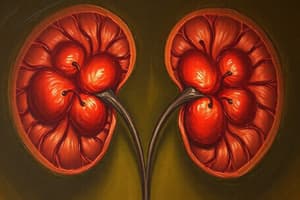Podcast
Questions and Answers
What characterizes the glomerular filtration phase of renal elimination?
What characterizes the glomerular filtration phase of renal elimination?
- It primarily removes highly charged drugs from the plasma.
- It filters a large volume of plasma without selectivity. (correct)
- It selectively filters lipophilic drugs preferentially.
- It is highly selective for drugs bound to plasma proteins.
Which statement is true about the renal excretion process?
Which statement is true about the renal excretion process?
- Passive tubular reabsorption occurs after active tubular secretion. (correct)
- 99% of the volume filtered in glomerular filtration is secreted in urine.
- Drugs bound to plasma proteins are easily filtered by the glomeruli.
- Active tubular secretion occurs before glomerular filtration.
What is the primary route of elimination for most drugs?
What is the primary route of elimination for most drugs?
- Pulmonary route is the main excretion pathway.
- Renal route is predominantly used for water-soluble drugs. (correct)
- Hepatic route is preferred for all drugs.
- Accessory routes are the primary elimination methods.
Which of the following statements is false regarding the hepatic route of elimination?
Which of the following statements is false regarding the hepatic route of elimination?
How does lipophilicity affect the reabsorption of drugs during renal elimination?
How does lipophilicity affect the reabsorption of drugs during renal elimination?
Which accessory route of drug elimination is specifically crucial for breastfeeding women?
Which accessory route of drug elimination is specifically crucial for breastfeeding women?
Which of the following is not a characteristic of glomerular filtration?
Which of the following is not a characteristic of glomerular filtration?
What is the main driving force for the filtration process occurring in the glomerulus?
What is the main driving force for the filtration process occurring in the glomerulus?
What is the role of the pulmonary route in drug elimination?
What is the role of the pulmonary route in drug elimination?
Which condition would increase the excretion of weak acids like barbituric acid?
Which condition would increase the excretion of weak acids like barbituric acid?
During renal elimination, which condition would most likely lead to minimal reabsorption?
During renal elimination, which condition would most likely lead to minimal reabsorption?
Which statement about tubular secretion in the nephron is correct?
Which statement about tubular secretion in the nephron is correct?
How does entero-hepatic circulation impact drug elimination?
How does entero-hepatic circulation impact drug elimination?
Which process is primarily responsible for the large volume of plasma reabsorption after glomerular filtration?
Which process is primarily responsible for the large volume of plasma reabsorption after glomerular filtration?
The clearance of a drug primarily indicates what?
The clearance of a drug primarily indicates what?
What role does the conjugation phase play in drug metabolism?
What role does the conjugation phase play in drug metabolism?
Which of the following statements is true regarding the excretion rate and elimination kinetics?
Which of the following statements is true regarding the excretion rate and elimination kinetics?
In which part of the nephron does active reabsorption of anions occur?
In which part of the nephron does active reabsorption of anions occur?
What is the importance of the concept of organ clearance?
What is the importance of the concept of organ clearance?
Which of the following describes the main characteristic of tubular reabsorption?
Which of the following describes the main characteristic of tubular reabsorption?
What is the renal clearance rate for a free drug that is not reabsorbed nor secreted?
What is the renal clearance rate for a free drug that is not reabsorbed nor secreted?
How does increased renal clearance affect the half-life of a drug?
How does increased renal clearance affect the half-life of a drug?
What condition might result in a total reabsorption of creatinine, leading to a clearance value of zero?
What condition might result in a total reabsorption of creatinine, leading to a clearance value of zero?
What happens to drug elimination when its plasma concentration exceeds a certain threshold?
What happens to drug elimination when its plasma concentration exceeds a certain threshold?
What does the Area Under the Curve (AUC) represent in pharmacokinetics?
What does the Area Under the Curve (AUC) represent in pharmacokinetics?
Which parameter is directly proportional to the half-life of a drug?
Which parameter is directly proportional to the half-life of a drug?
How can a doctor estimate the glomerular filtration rate (GFR)?
How can a doctor estimate the glomerular filtration rate (GFR)?
What characterizes a single compartment pharmacokinetic model?
What characterizes a single compartment pharmacokinetic model?
What is the expected AUC if a drug is administered at dose D with 100% bioavailability?
What is the expected AUC if a drug is administered at dose D with 100% bioavailability?
What effect does a slow absorption formulation have on drug plasma concentration?
What effect does a slow absorption formulation have on drug plasma concentration?
Flashcards are hidden until you start studying
Study Notes
Elimination Phase in Pharmacokinetics
- The elimination phase is the final stage of pharmacokinetics, involving drug excretion processes.
- Main routes of elimination: renal (kidneys), hepatic (liver), pulmonary (lungs).
- Accessory routes include saliva, sweat, tears, milk, hair, and skin.
Renal Elimination
- Renal elimination is the primary route, primarily for water-soluble substances.
- Involves three main processes: glomerular filtration, active tubular secretion, and passive tubular reabsorption.
Glomerular Filtration
- Characterized by a large volume of plasma filtered by the glomeruli.
- Plasma-bound drugs cannot be filtered; only free drugs are later reabsorbed.
- Filtration is driven by blood hydrostatic pressure; important substances like proteins and blood cells are retained in circulation.
Tubular Reabsorption
- A passive diffusion mechanism influenced by urinary pH; affects the excretion of weak acids and bases.
- Weak acids are reabsorbed in acidic urine, while weak bases are favored in basic urine.
- Ionized molecules are excreted, allowing manipulation of urine pH to enhance drug elimination.
Tubular Secretion
- An active process involving two transport systems: one for organic anions (e.g., diuretics, NSAIDs) and one for organic cations (e.g., morphine).
- Both systems can be subject to competition and saturation, affecting secretion efficacy.
Hepatic-Biliary Excretion
- Drugs can be metabolized in the liver and excreted via bile.
- Biliary excretion is influenced by drug polarity and molecular weight; larger, hydrophilic substances are targeted.
- Entero-hepatic circulation prolongs drug activity by recycling some substances back into circulation.
Elimination Kinetics
- Drug elimination typically follows first-order kinetics: a constant fraction of the drug is eliminated over time.
- Ke (elimination rate constant) indicates the elimination velocity; inversely related to half-life.
- Total clearance (Cl) relates clearance rates of various organs responsible for drug excretion.
Clearance
- The rate at which a drug is removed from the plasma, measured in ml/min or L/hr.
- Renal clearance reflects kidney function: 20% filtration rate (~130 ml/min) in healthy individuals.
- Increased creatinine levels indicate reduced renal clearance, affecting drug half-life.
Half-Life
- The half-life of a drug is the time required for plasma concentration to reduce by half.
- Influenced by clearance (inversely) and volume of distribution (directly).
- Abnormalities in organ function lead to increased half-life and extended therapeutic effects.
AUC (Area Under the Curve)
- Represents drug bioavailability; correlates with the amount of unchanged drug reaching circulation.
- AUC can be calculated to assess total plasma concentration and elimination rate.
- Understanding absorption and elimination speeds helps optimize drug dosing for therapeutic efficacy.
Studying That Suits You
Use AI to generate personalized quizzes and flashcards to suit your learning preferences.




